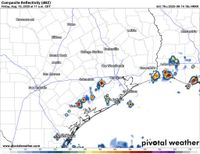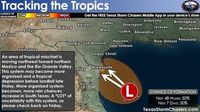On August 15, 2025, the Texas Gulf Coast found itself under the watchful eye of meteorologists as Invest 98L, a tropical disturbance, hovered offshore and threatened to bring heavy rainfall and flash flooding to a broad swath of the region. While the system’s potential to develop into a tropical depression or storm fluctuated throughout the day, forecasters agreed on one thing: the real hazard would be water, not wind.
According to the National Hurricane Center, Invest 98L was given a 50/50 chance of developing into a weak tropical system before making landfall along the Texas-Mexico border by Friday evening. Yet, as the hours passed, the likelihood of significant tropical development waned. By early Friday afternoon, AccuWeather reported that the window for formation had closed, as the main cluster of showers and thunderstorms moved inland over northeastern Mexico and South Texas.
Still, the threat was far from over. The disturbance, which originated in the western Caribbean earlier in the week and traveled thousands of miles into the Gulf, was now poised to deliver a surge of tropical moisture across southern and central Texas. AccuWeather’s Lead Hurricane Expert Alex DaSilva warned, “People in areas prone to flash flooding should be on alert.”
Friday morning’s satellite imagery showed a disorganized but persistent cluster of showers and thunderstorms just offshore. Hurricane hunters flying through the system found it to be a poorly organized cluster, but noted that extremely warm waters and a lack of wind shear could still promote some last-minute development as the system moved northwest toward the Rio Grande Valley. The National Hurricane Center noted, “Aircraft wind data and coastal radar data indicate that a closed circulation is not present.”
The forecast for Friday called for scattered to numerous thunderstorms along the Texas Gulf Coast and adjacent inland areas. The highest likelihood of heavy rain was forecast for the lower Texas Gulf Coast and the Rio Grande Valley, including cities like McAllen and Brownsville. The flash flood outlook placed a level 2 of 4 risk (at least a 15% chance) of flash flooding across the Rio Grande Valley and a level 1 of 4 risk (at least a 5% chance) along the remainder of the coast. Hourly rainfall rates of up to four inches were possible, and the risk of brief tornadoes, dangerous cloud-to-ground lightning, and gusty winds could not be ruled out.
Houston, too, braced for impact. The Houston Chronicle reported that flood risk would peak Friday afternoon and early evening, especially near and south of Interstate 10. Commuters were warned of spotty downpours and the potential for localized street flooding, particularly in low-lying or flood-prone neighborhoods. Most of Southeast Texas was expected to receive between half an inch and an inch of rain through Sunday morning, with higher totals possible in isolated spots.
As the system tracked inland, the focus shifted to the risk of flash flooding further north and west. AccuWeather highlighted that the greatest concern extended from the lower Rio Grande Valley through San Antonio and into the Texas Hill Country—areas all too familiar with the dangers of sudden floods. In early July, more than 100 people lost their lives to flash floods at campsites along the Guadalupe River, a tragedy still fresh in the minds of many Texans.
For San Antonio, Friday brought mostly sunny skies and temperatures near the 98-degree mark, with only a 10-20% chance of an isolated afternoon shower or storm. But by Saturday, remnant moisture from the Gulf disturbance was expected to increase rain chances, especially in the morning. The city’s rain chances would peak at around 40% early, dropping to 20% by evening. Most areas were forecast to receive less than half an inch of rain, though isolated spots could see totals greater than an inch thanks to elevated atmospheric moisture. The increased cloudiness would bring a slight dip in high temperatures, with Saturday’s highs expected to top out between 94 and 96 degrees.
Elsewhere, the tropical moisture was expected to linger into Saturday, keeping the risk of afternoon downpours alive for Southeast Texas. The Houston Chronicle advised residents to stay ready to duck indoors if thunder rumbled nearby, as heavy rainfall wouldn’t last long in any one spot but could cause quick street flooding before moving on. By Sunday, rain chances would decrease to 30-40%, and daytime highs in Houston were forecast to climb into the upper 90s, with heat index values reaching between 104 and 106 degrees—a sweltering reminder that summer was far from over.
Dangerous rip currents were another concern along the entire Texas Gulf Coast, as the system’s influence churned up the surf. Beachgoers were urged to exercise caution throughout the weekend.
Looking ahead, the moisture from Invest 98L was projected to dissipate quickly as it encountered dry air later Saturday into Sunday. By next week, the Gulf low would fizzle out, leaving behind hot, seasonable August weather for South Texas. San Antonio’s highs were expected to rebound into the upper 90s and possibly touch 100 degrees by Monday, while rain chances would drop below 10%. However, midweek could bring a weak cold front and a modest uptick in scattered storm chances, giving residents a brief respite from the heat.
Meanwhile, in the Atlantic, a different story was unfolding. Hurricane Erin became the basin’s first hurricane of the season on Friday morning, setting its sights on the Leeward Islands and Puerto Rico for the weekend. Erin was expected to pass between the U.S. East Coast and Bermuda next week, stirring up dangerous surf and rip currents—another reminder of the far-reaching impacts of tropical weather systems.
Despite the uncertainty that shrouded Invest 98L’s development, the message from meteorologists was clear: don’t let your guard down. The system’s lack of organization didn’t mean the absence of danger. As history has shown, even weak or non-tropical disturbances can unleash serious flooding, especially in a state as vast and varied as Texas. With memories of July’s Guadalupe River tragedy still vivid, officials and experts urged residents to stay informed, monitor local forecasts, and take every warning seriously. After all, when it comes to Texas weather, it’s always better to be safe than sorry.





